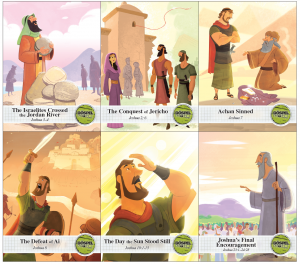On Wednesday and Sunday evenings Valdosta Kids we are currently going through Lifeway’s the Gospel Project. We began in Genesis with creation, progressed through Moses’ leadership and the wilderness, and are currently beginning a new series on the book of Judges. What I like most about the curriculum, other than pointing every character and book to Christ, is how they have a “big idea†question for each lesson.
 Before we begin a new lesson or introduce a new character we quickly review previous weeks by reading these questions.[1] This forms over a three year period a type of catechism for the children. Traditionally, Baptists have moved away from catechismal type of questioning for various reasons (see linked article below), but this is a good example of how one can cover and review large sections of material very quickly.
Before we begin a new lesson or introduce a new character we quickly review previous weeks by reading these questions.[1] This forms over a three year period a type of catechism for the children. Traditionally, Baptists have moved away from catechismal type of questioning for various reasons (see linked article below), but this is a good example of how one can cover and review large sections of material very quickly.
 The following is an excerpt of an article written by John Piper and posted to the desiringgod.org website.[2]
The following is an excerpt of an article written by John Piper and posted to the desiringgod.org website.[2]
 A Catechism?
1. What is a catechism?
In 1 Corinthians 14:19 Paul says, “In the church I would rather speak five words with my mind, in order to instruct others, than ten thousand words in a tongue.” In Galatians 6:6 he says, “Let him who is taught the word share all good things with him who teaches.” Acts 18:25 says that Apollos “has been instructed in the way of the Lord.”
In each of these verses the Greek word for “instruct” or “teach” is katecheo. From this word we get our English word “catechize”. It simply means to teach Biblical truth in an orderly way. Generally this is done with questions and answers accompanied by Biblical support and explanation.
2. What is the history of this catechism?
This is a slightly revised version of “The Baptist Catechism” first put forth by Baptists in 1689 in Great Britain. It was adopted by the Philadelphia Baptist Association in 1742. It is patterned on the well-known reformed Westminster Catechism. The few comments in the earlier questions are meant to help parents make things plain to their children.
3. Is there a Biblical pattern of doctrine?
Several texts teach that there is. For example, in Romans 6:17 Paul gives thanks that “you have become obedient from the heart to the pattern of teaching to which you were committed.” 2 Timothy 1:13 says, “Follow the pattern of sound words which you heard from me.” Acts 2:42 says, “They devoted themselves to the apostles’ teaching.” 2 Thessalonians 2:15 says, “Stand firm and hold to the traditions which you were taught by us.” And Acts 20:27 says, “I did not shrink from declaring to you the whole counsel of God.”
So it appears that there was a body of authoritative instruction and even a way of teaching it in the early church.
4. Why is it important?
- We are required to “continue in the faith, stable and steadfast” (Col. 1:23).
- We are urged to “attain to the unity of the… knowledge of the Son of God…so that we may no longer be children, tossed to and fro and carried about by every wind of doctrine” (Eph. 4:13-14).
- There are many deceivers (1 John 2:26).
- There are difficult doctrines “which the ignorant and unstable twist to their own destruction” (2 Peter 3:16).
- Leaders must be raised up who can “give instruction in sound doctrine and also confute those who contradict it” (Titus 1:9).
5. How shall we begin?
Make them part of your family routine or just use them for yourself. I am excited about being a partner with you in building a “stable and firm” generation who hopes in God.
Learning and teaching with you,
Pastor John
I included this excerpt by John Piper because of his emphasis on using it to teach children and how this methodology links the church and home. Â Click here to see related articles that deal with catechism and teaching children.
[1] Click here to see why review is so important.
[2] http://www.desiringgod.org/articles/a-baptist-catechismhttp://www.desiringgod.org/articles/a-baptist-catechism